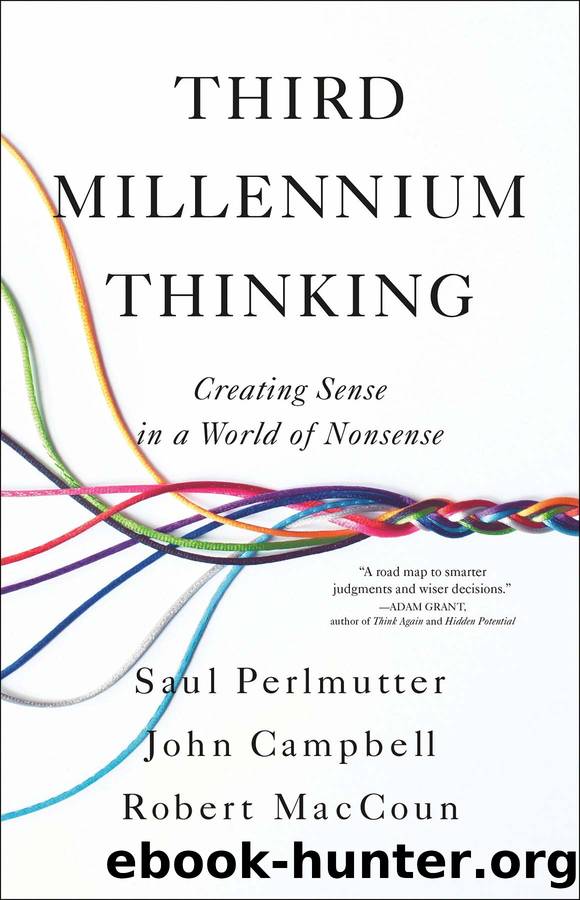Third Millennium Thinking by Saul Perlmutter

Author:Saul Perlmutter [Saul Perlmutter, John Campbell and Robert MacCoun]
Language: eng
Format: epub
Publisher: Little, Brown and Company
Published: 2024-03-02T00:00:00+00:00
THE CAN-DO SPIRIT PAYS OFF
The idea of Fermi problems goes back to the famous physicist Enrico Fermi, who was always challenging his students with problems that required quick, on-the-spot estimations. Presumably, Fermi didnât call these Fermi estimates, but ever since, generations of physicists have been challenged to give rapid estimations to answer these âFermi problems.â69 A famous example from Fermi was: How many piano tuners are there in Chicago? (Letâs use this Fermi problem as a challenge for us authors: By the end of this chapter we should leave the readers in a position to answer it themselves.)
Fermi estimates serve the very practical function of helping us differentiate first-order explanations from second-order. And in a world where numbers are thrown around to prove points, itâs also a remarkably useful technique for checking whether those numbers make any sense. But Fermi was probably also interested in the can-do spirit that the students learned when they became comfortable with this rapid estimation approach. It ends up feeling quite empowering to realize that we can get a handle on the world in this way.
Before we apply Fermiâs estimation approach to our government social spending estimates, letâs start with a different, somewhat simpler, example. Imagine that youâre trying to estimate how many cars there are in the United States. You donât have access to the internet, so you are limited to knowledge you have in your head. The first step is to ask yourself how you could get at this estimate based on other estimates that might be easier to do because they are more familiar. You try out a few ideas and quickly discard them because they donât seem easier: e.g., estimating the miles of roads in the US and how many cars there are per mile of road, or estimating the number of cities in the US and how many cars there are in each city. But then you think you might try estimating the number of people in the United States and then what proportion own a car, since many of us have some idea of the population of the US, and the car ownership patterns among our friends and acquaintances can help us estimate the number of cars per person.
You might remember that the population of the US surpassed 300 million in recent decades. So you can use the 300 million figure or something a little higher to account for population growth since then. Letâs use 330 million, 10 percent higher.
If everybody had a car, there would be about 330 million cars. But not everybody has a car. Babies and children donât have cars. Many young adults donât have cars. Lots of older people share cars. On the other hand, some people have more than one car, and some families have almost as many cars as family members. So maybe there are about half as many cars as people. This would suggest that there are 165 million cars out there on the road. We are probably off by millions or
Download
This site does not store any files on its server. We only index and link to content provided by other sites. Please contact the content providers to delete copyright contents if any and email us, we'll remove relevant links or contents immediately.
Hit Refresh by Satya Nadella(9038)
The Compound Effect by Darren Hardy(8808)
Change Your Questions, Change Your Life by Marilee Adams(7635)
Nudge - Improving Decisions about Health, Wealth, and Happiness by Thaler Sunstein(7615)
The Black Swan by Nassim Nicholas Taleb(7010)
Deep Work by Cal Newport(6879)
Daring Greatly by Brene Brown(6445)
Rich Dad Poor Dad by Robert T. Kiyosaki(6401)
Principles: Life and Work by Ray Dalio(6211)
Man-made Catastrophes and Risk Information Concealment by Dmitry Chernov & Didier Sornette(5921)
Playing to Win_ How Strategy Really Works by A.G. Lafley & Roger L. Martin(5919)
Digital Minimalism by Cal Newport;(5664)
Big Magic: Creative Living Beyond Fear by Elizabeth Gilbert(5610)
The Myth of the Strong Leader by Archie Brown(5425)
The Slight Edge by Jeff Olson(5346)
Discipline Equals Freedom by Jocko Willink(5285)
The Motivation Myth by Jeff Haden(5156)
Stone's Rules by Roger Stone(5026)
The Laws of Human Nature by Robert Greene(4998)
